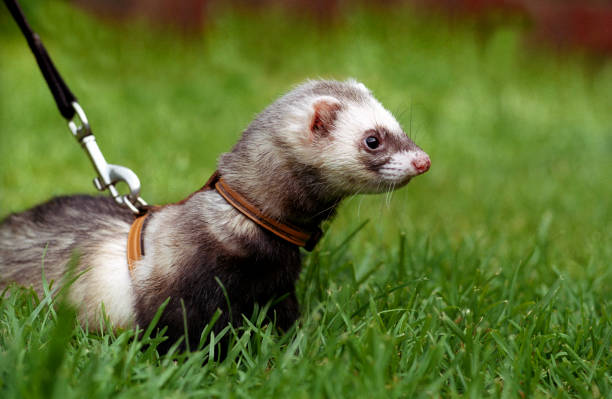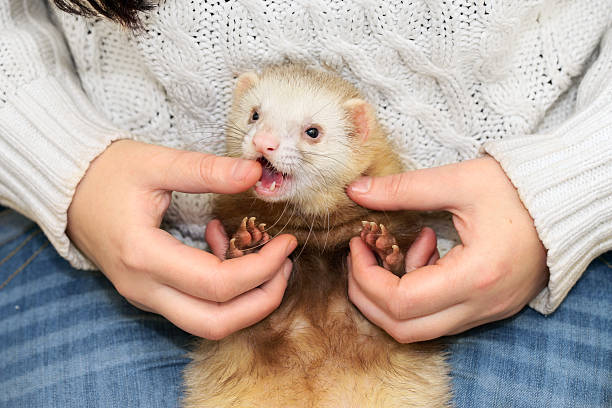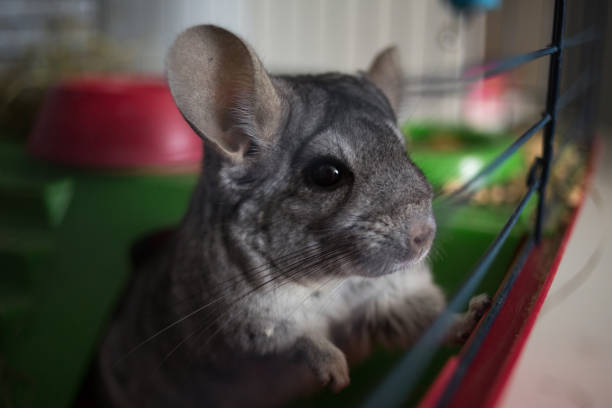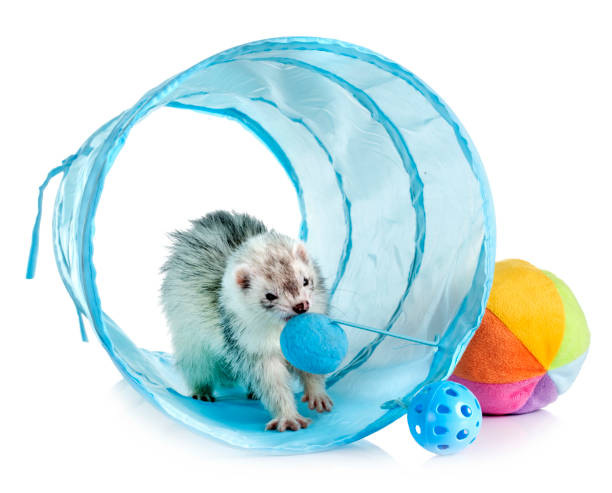Ferret Whispering: How to Tame and Train Your Playful Pet
This post contains affiliate links. This means I will make a commission at no extra cost to you should you click through and make a purchase. Read the full disclosure here.
Ferrets, with their mischievous antics and boundless energy, have a special way of stealing hearts and filling homes with joy. These captivating creatures are not just pets; they’re playful and inquisitive companions ready to embark on exciting adventures with their human families. In this comprehensive guide, we will unlock the secrets of taming and training your furry ferret friend, helping you build a strong and lasting bond.
Understanding Ferret Behavior
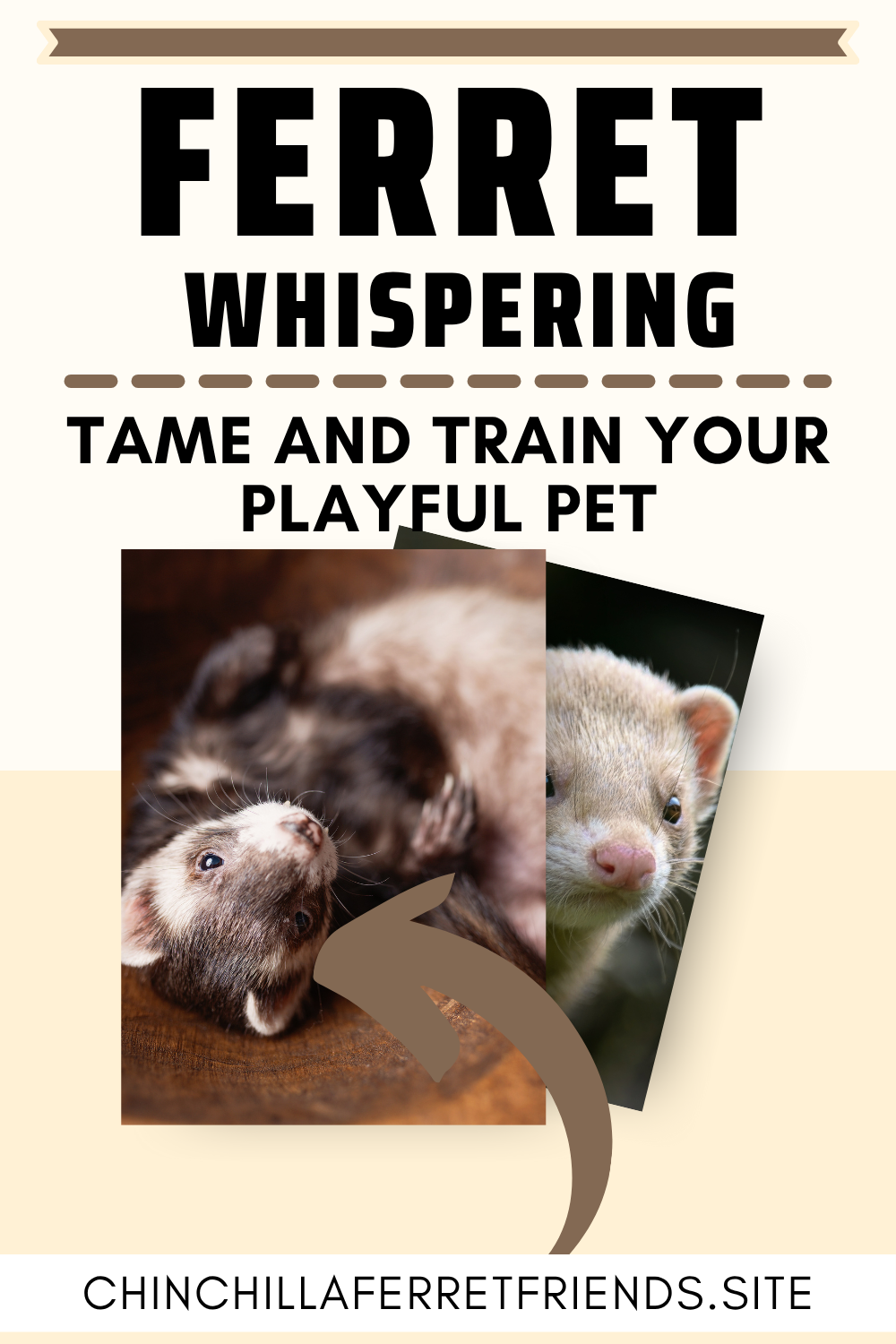
Before you embark on the journey of taming and training your ferret, it’s essential to grasp the fundamentals of its behavior. Ferrets have a unique set of instincts and traits that shape their actions. Understanding these characteristics will lay the foundation for successful training and a harmonious relationship.
1. The Curious Explorer
Ferrets are natural explorers. They have an insatiable curiosity that drives them to investigate every corner of their environment. You’ll often find them darting under furniture, peeking into crevices, and investigating anything new in their surroundings.
Training Tip: Embrace their curiosity during training sessions by introducing them to new toys, objects, or challenges. This keeps their minds engaged and channels their energy positively.
2. Social Butterflies
Ferrets are highly social animals. They thrive on interaction with their human companions and other ferrets. This social nature is a defining characteristic of their behavior, making them eager to engage in playtime and bonding activities.
Training Tip: Use social interaction as a reward during training. Ferrets respond well to praise, attention, and affection. Positive reinforcement strengthens your bond and encourages desired behaviors.
3. The Natural Digger
In the wild, ferrets are burrowers. They dig tunnels and create elaborate underground homes. This behavior often carries over into domesticated ferrets, who may attempt to dig in carpets, bedding, or soft furnishings.
Training Tip: Provide an outlet for their digging instincts. Offer a designated digging box filled with safe materials like rice or small, soft toys. Redirecting this behavior prevents damage to your home.
4. Energetic Playfulness
Ferrets are renowned for their playful and energetic nature. They engage in games of chase, hide-and-seek, and mock combat with other ferrets and their human companions. This boundless energy is a joy to witness but also requires appropriate outlets.
Training Tip: Incorporate playtime into your daily routine. Interactive toys, tunnels, and games like “fetch” can help burn off excess energy and prevent boredom.
5. Nocturnal Habits
Ferrets are crepuscular, which means they are most active during dawn and dusk. While they can adjust to your schedule, it’s essential to provide stimulating activities and play during their active periods to ensure a well-balanced routine.
Training Tip: Schedule training and play sessions during their peak activity times to maximize engagement and learning.
By understanding these fundamental aspects of ferret behavior, you’re better prepared to tailor your training approach to their unique needs. In the next section, we’ll delve into the initial steps of the taming process, helping you establish trust and build a strong foundation for training.
The Taming Process

Taming a ferret, especially if it’s a young kit, is a rewarding but delicate process. It involves building trust, establishing boundaries, and creating a positive association with human interaction. Let’s dive into the steps of the taming journey with your playful pet.
1. Patience Is Your Best Ally
The key to successful taming is patience. Begin by allowing your ferret to acclimate to its new environment. Give them time to explore their cage or playpen without pressure. This initial period helps them feel secure in their surroundings.
Training Tip: Avoid overwhelming your ferret with too much handling or interaction in the first few days. Allow them to approach you at their own pace.
2. The Gentle Approach
When you do start interacting with your ferret, be gentle and non-threatening. Use slow movements and speak softly to avoid startling them. Offer treats or small pieces of their favorite food to create positive associations with your presence.
Training Tip: Sit near the ferret’s cage or play area and let them come to you. Allow them to sniff your hand and offer treats as a reward for approaching.
3. Hands-On Socialization
Gradually increase the amount of time you spend handling your ferret. Start with short, positive interactions and gradually extend the duration as your ferret becomes more comfortable. Use this time for gentle petting, bonding, and providing treats.
Training Tip: Always approach your ferret from the front, rather than reaching from behind, to avoid startling them. Speak in soothing tones to reassure them during handling.
4. Building Trust Through Play
Play is an excellent way to build trust and strengthen your bond. Engage your ferret in interactive games with toys such as feather wands, tunnels, and balls. These activities not only provide mental stimulation but also create positive associations with your presence.
Training Tip: Encourage playfulness by allowing your ferret to initiate play. Be responsive to their cues and adjust the intensity of play to their comfort level.
5. Respect Boundaries
As you progress with taming, it’s essential to recognize your ferret’s boundaries. Pay attention to their body language. If they show signs of stress or discomfort, such as hissing, arching their back, or trying to escape, give them space and return to a more comfortable interaction later.
Training Tip: Gradually work on expanding your ferret’s comfort zone by exposing them to new experiences and people in a controlled and positive manner.
Remember, every ferret is unique, and the taming process may vary from one individual to another. It’s crucial to respect their pace and preferences. With patience, consistent positive interactions, and the gradual building of trust, you’ll be well on your way to having a well-adjusted and sociable ferret companion.
Basic Training Commands
Teaching your ferret basic training commands is not only a practical way to ensure their safety and well-being but also a means to strengthen your bond and stimulate their clever minds. In this section, we’ll explore essential commands and how to effectively train your playful pet.
1. “Come” Command
The “come” command is crucial for calling your ferret back to you, especially when they are exploring or playing in areas where you want them to return.
Training Steps:
- Start in a quiet room with minimal distractions.
- Hold a treat in your hand and say “come” while crouching or kneeling.
- Gently pat your knee or the ground to encourage them to approach.
- When they come to you, reward them with a treat and lots of praise.
Training Tip: Be patient, as it may take time for your ferret to associate the word “come” with the action. Practice in short sessions and gradually increase the distance.
2. “Stay” Command
The “stay” command helps keep your ferret in place when necessary, preventing them from entering potentially hazardous situations.
Training Steps:
- Start with your ferret in a small, confined space like a playpen.
- Hold a treat in your hand and say “Stay.”
- Step a short distance away while keeping eye contact with your ferret.
- If they remain in place, reward them with the treat and praise.
Training Tip: Keep training sessions brief and gradually increase the duration of the “stay” as your ferret becomes more accustomed to the command.
3. “No” Command
The “no” command is essential for discouraging undesirable behavior, such as biting or chewing on cords.
Training Steps:
- When your ferret engages in undesirable behavior, firmly say “no.”
- Redirect their attention to an appropriate toy or activity.
- Reward and praise them when they switch to acceptable behavior.
Training Tip: Consistency is key. Always use the same word (“no”) and tone when correcting the behavior to avoid confusion.
4. “Up” and “Down” Commands
Teaching your ferret to go up and down on command can be helpful for getting them in and out of their cage or play area.
Training Steps:
- For “up,” hold a treat above your ferret’s head and say “up.”
- For “down,” hold a treat near the ground and say “down.”
- Use gestures to help convey the desired action.
- Reward them with treats and praise when they follow the command.
Training Tip: Practice these commands during cage or playpen time to reinforce the behavior.
5. “Leave It” Command
The “leave it” command is crucial for preventing your ferret from picking up and potentially ingesting harmful objects.
Training Steps:
- Hold a treat in your hand and show it to your ferret.
- Say “Leave it” and close your hand around the treat.
- Wait for them to lose interest in trying to get the treat.
- Open your hand and reward them with a different treat and praise.
Training Tip: Gradually increase the difficulty by using more tempting items to “leave.”
Remember that training should always be positive and reward-based. Ferrets respond well to treats and praise, so be generous with both when they follow commands correctly. Consistency and patience will lead to a well-trained and cooperative ferret companion.
Litter Training
Litter training is a fundamental aspect of ferret care that not only keeps your home clean and odor-free but also enhances your ferret’s quality of life. Ferrets are naturally inclined to use a designated area for elimination, making litter training a relatively straightforward process.
1. Choosing the Right Litter Box
Selecting the appropriate litter box is the first step in successful litter training. Ferrets prefer boxes that are:
- Low-sided for easy access.
- Large enough for them to comfortably turn around.
- Easy to clean.
Consider having multiple litter boxes in different areas of your home, especially if you have a large living space.
2. The Right Litter Material
Ferrets have specific preferences when it comes to litter material. They tend to prefer pelleted litters or paper-based litters over clumping clay litter. These materials are less likely to be ingested if your ferret decides to dig or play in the box.
3. Introducing Your Ferret to the Litter Box
To introduce your ferret to the litter box:
- Place your ferret in the litter box after they wake up, after eating, or when you observe them displaying signs of needing to go (sniffing or circling).
- Gently scratch the litter with your finger to simulate digging.
- Be patient and wait for them to eliminate.
4. Positive Reinforcement
When your ferret uses the litter box correctly, provide immediate positive reinforcement. Offer a treat and praise them to create a positive association with the behavior. Consistency is key.
5. Dealing with Accidents
If your ferret has an accident outside the litter box, clean the area thoroughly to remove the scent, which might attract them to that spot in the future. Avoid using ammonia-based cleaners, as they may smell similar to the urine of a ferret.
6. Maintaining a Clean Litter Box
Ferrets are more likely to use a clean litter box. Scoop waste daily and replace the litter regularly. Wash the litter box with a mild, ferret-safe detergent during litter changes.
7. Be Patient and Persistent
Litter training may take some time, especially for young ferrets or those new to your home. Be patient, and continue reinforcing positive behavior with treats and praise.
8. Medical Issues
If your ferret suddenly stops using the litter box or shows signs of discomfort while urinating or defecating, consult with a veterinarian. Litter box issues can sometimes indicate underlying health problems.
Advanced Training and Enrichment

While basic commands and litter training are essential for a well-behaved ferret, advanced training and enrichment activities take their mental stimulation and physical well-being to the next level. In this section, we’ll explore how to challenge your playful pet with fun and engaging activities.
1. Teaching Tricks
Ferrets are intelligent creatures capable of learning tricks and commands beyond the basics. Here are a few tricks you can teach your ferret:
- Roll Over: Begin by having your ferret lie down, then gently roll them onto their back. Reward and praise when they complete the motion. Gradually reduce your assistance until they can do it on their own.
- Spin: Hold a treat above your ferret’s nose and slowly move it in a circle. Your ferret will follow the treat with their head, eventually spinning around. Reward and praise the completed spin.
- Fetch: Ferrets can be taught to fetch small toys. Start by tossing a toy a short distance. When your ferret retrieves it, reward them with a treat and plenty of praise. Gradually increase the distance.
- Hide and Seek: Hide in a room or behind furniture, then call your ferret. When they find you, reward them with treats and affection.
2. Agility Training
Creating a miniature agility course for your ferret can provide both physical exercise and mental stimulation. Use tunnels, ramps, hoops, and obstacles to design a course. Encourage your ferret to navigate the course using treats and toys as motivation.
Training Tip: Always ensure the course is safe and secure to prevent injury.
3. DIY Toys and Games
Ferrets enjoy interactive toys and games that challenge their problem-solving skills. Consider creating homemade toys and puzzles using cardboard boxes, paper bags, or PVC pipes. Hide treats or toys inside these items, encouraging your ferret to figure out how to access the goodies.
4. Rotating Toys
Ferrets can become bored with their toys if they’re always available. Rotate their toys every few weeks to keep their interest piqued. When reintroducing a toy they haven’t seen in a while, it’s like a brand-new plaything to them.
5. Playtime Partners
If you have more than one ferret, they can engage in playful interaction with each other. Multiple ferrets can create their games and wrestling matches, providing ample exercise and entertainment.
6. Puzzle Feeders
Puzzle feeders are excellent for mental stimulation. These toys dispense food when your ferret figures out the correct way to manipulate them. It’s a fun and rewarding way for them to enjoy their meals.
Grooming and Hygiene

Maintaining your ferret’s hygiene is an essential part of responsible pet ownership. Ferrets are naturally clean animals, but they may require some assistance to keep their coat, nails, and ears in tip-top shape. Let’s explore the key aspects of grooming and hygiene for your furry friend.
1. Bathing Your Ferret
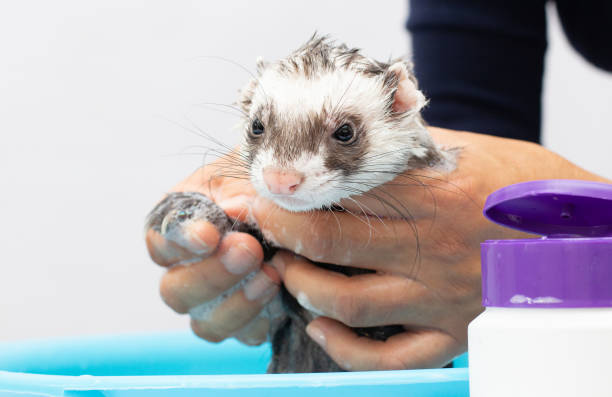
Ferrets are known for their natural musky odor, which can become more noticeable over time. While some degree of scent is normal, regular bathing can help control it. Here’s how to bathe your ferret:
- Frequency: Ferrets generally do not need frequent baths. Bathing every 1-2 months is typically sufficient. Bathing too often can strip their skin of essential oils.
- Use a Ferret-Safe Shampoo: Use a mild, ferret-specific shampoo to avoid skin irritation. Ensure the water is lukewarm, and gently wet your ferret’s fur.
- Lathering and Rinsing: Apply a small amount of shampoo and lather it through the coat. Be gentle and avoid getting water or soap in their eyes, ears, or nose. Rinse thoroughly until the water runs clear.
- Drying: Pat your ferret dry with a towel and ensure they are completely dry before returning them to their living space. You can use a hairdryer on a low, cool setting, but be cautious not to overheat your ferret.
2. Nail Trimming

Regular nail trimming is vital to prevent overgrown nails, which can become painful and cause injury to your ferret. Here’s how to trim their nails safely:
- Gentle Handling: Begin by gently handling your ferret’s paws regularly to get them used to the sensation.
- Use Proper Nail Clippers: Invest in small, animal-specific nail clippers, and only trim a small amount of the nail at a time to avoid cutting quickly (the pink area with blood vessels).
- Enlist Help: If you’re uncertain about trimming, consider seeking assistance from a veterinarian or an experienced ferret owner.
3. Coat Maintenance

Ferrets have a dense, soft coat that can become greasy or develop mats if not properly maintained. Regular brushing with a soft brush or a ferret-specific grooming mitt can help keep their coat healthy and reduce shedding.
- Check for Mats: Inspect your ferret’s coat for mats or tangles regularly. If you find any, gently work them out with your fingers or a detangling spray.
4. Ear Cleaning

Ferrets are prone to earwax buildup and ear mites. Check their ears regularly and clean them with a specialized ferret ear cleaner if needed. Be gentle and avoid inserting anything deep into their ear canal.
5. Dental Care

While not technically grooming, dental care is crucial for your ferret’s overall health. Provide chew toys and dental treats to help keep their teeth clean and prevent dental issues.
By incorporating these grooming and hygiene practices into your ferret’s routine, you’ll help ensure their comfort, health, and overall well-being.
Training and Behavior
Ferrets are naturally inquisitive and playful, but like all pets, they may occasionally exhibit unwanted behaviors. Understanding how to train and modify their behavior effectively can lead to a harmonious life together.
1. Litter Training Reinforcement

Litter training should be consistently reinforced throughout your ferret’s life. If you notice any lapses in litter box use, revisit the basics:
- Positive Reinforcement: Reward your ferret with treats and praise every time they use the litter box correctly.
- Consistency: Maintain a clean litter box, as ferrets are more likely to use a tidy one.
- Location: Ensure litter boxes are conveniently placed in multiple areas of your home.
2. Biting and Nipping
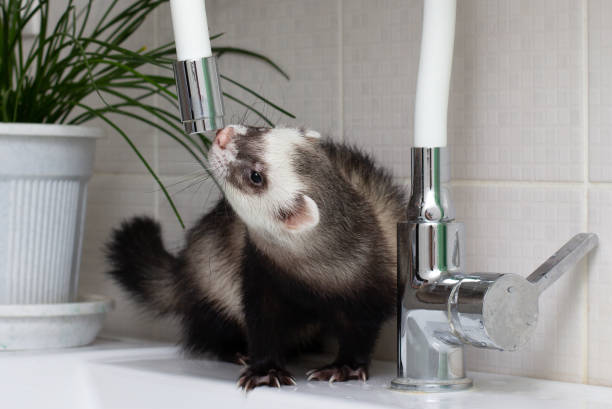
Ferrets have a playful nature, but biting or nipping can be an issue, especially with young ferrets. Here’s how to address it:
- Redirect Play: If your ferret bites during play, gently redirect their attention to toys or a stuffed animal. This helps teach them appropriate biting targets.
- Squeal Technique: If your ferret bites too hard during play, squeal in a high-pitched voice to mimic the sound of a ferret in distress. This usually startles them and discourages the behavior.
- Avoid Rough Play: Encourage gentler play and discourage rough wrestling or biting.
3. Scratching and Digging

Ferrets may scratch or dig at carpets and furniture. Here’s how to deal with this behavior:
- Provide Scratching Posts: Offer designated scratching posts or mats to satisfy their need to scratch. Place them near areas where they tend to scratch.
- Discourage Scratching: When you catch your ferret scratching inappropriately, gently redirect them to the scratching post and reward them when they use it.
4. Nipping During Handling
Some ferrets may nip when they feel uncomfortable during handling. Here’s how to address it:
- Gentle Handling: Be gentle and calm when picking up or handling your ferret. Use positive reinforcement like treats and praise to create positive associations with being handled.
- Desensitization: Gradually desensitize your ferret to handling. Start with brief sessions and gradually increase the duration.
- Patience: Be patient, especially if your ferret is new to handling or has had negative experiences in the past. Building trust takes time.
5. Litter Box Accidents
If your ferret has litter box accidents, don’t scold or punish them. Instead:
- Clean Thoroughly: Clean the accident area thoroughly to remove the scent.
- Review the Basics: Revisit the litter training basics, ensuring the litter box is clean and conveniently located.
6. Seek Professional Help
If you’re struggling with persistent behavioral issues, consider seeking advice from a veterinarian with experience in ferret behavior or consulting with a professional animal behaviorist.
Understanding and addressing your ferret’s behavior with patience, positive reinforcement, and consistent training techniques can lead to a well-adjusted and enjoyable pet-owner relationship.
Ferret Socialization

Ferrets are incredibly social creatures, both with humans and their fellow ferrets. Socialization is an integral part of their well-being, and understanding their social nature can help you provide a fulfilling life for your furry friends.
1. Interactions with Humans

Ferrets form strong bonds with their human companions. To enhance their socialization with you:
- Daily Interaction: Spend quality time with your ferret every day. This can include playtime, cuddles, or simply having them nearby while you work or relax.
- Positive Reinforcement: Use positive reinforcement, such as treats and praise, during interactions to strengthen your bond.
- Variety of Experiences: Expose your ferret to various experiences and environments, including new people and places, to help them become more adaptable and confident.
2. Interaction with Other Ferrets

Ferrets are generally more content when they have a companion of their own kind. Here are some benefits of having multiple ferrets:
- Companionship: Ferrets are highly social animals and thrive when they have a playmate. Having another ferret provides constant companionship and entertainment.
- Reduced Boredom: Multiple ferrets engage in interactive play and games, reducing the risk of boredom-related behavior issues.
- Simulated Hunting and Play: Ferrets play by chasing, wrestling, and mock fighting, which is a natural part of their behavior. With a companion, they can engage in these activities regularly.
- Help with Socialization: If you have a single ferret, consider introducing them to a new ferret gradually. This can provide valuable socialization experiences and reduce the likelihood of loneliness.
3. Socializing with Other Pets

If you have other pets, it’s important to introduce them to your ferrets safely and gradually. Not all pets are naturally compatible with ferrets, so it’s crucial to monitor their interactions closely.
- Supervised Introduction: Always supervise interactions between ferrets and other pets, especially dogs and cats.
- Positive Associations: Use treats and praise to create positive associations between your ferrets and other pets.
- Separate Spaces: Ensure your ferrets have their safe, separate living space to retreat to if needed.
- Consult a Professional: If you have concerns about introducing your ferret to other pets, consult a professional animal behaviorist for guidance.
By fostering positive socialization experiences for your ferrets, whether with humans, fellow ferrets, or other pets, you’ll contribute to their overall happiness and well-being. Remember that every ferret is unique, and their social needs may vary. Pay close attention to their cues and preferences to create a nurturing and enriched social environment.

Final Thoughts
Remember that every ferret is unique, so it’s essential to tailor your care and training approach to their individual personality and needs. With dedication and love, your ferret can become a cherished member of your family, bringing joy and laughter to your life.
I hope this guide has been valuable in your journey as a responsible ferret owner. If you have more questions or need further information, feel free to explore other articles on our website’s Ferret category or reach out to ferret enthusiasts and experts in online forums and communities.
Here’s to a happy and thriving life with your furry ferret friends!



